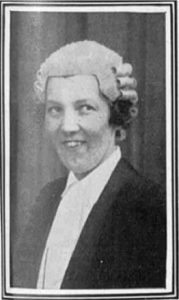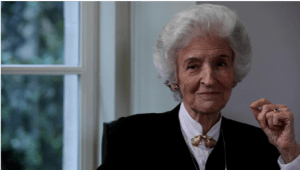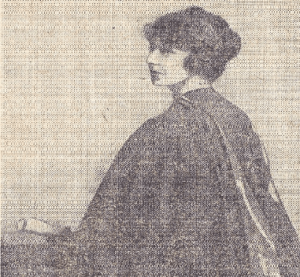Helena Kennedy QC
Helena Kennedy QC was born and grew up in the South side of Glasgow. She was, at first, going to study English at Glasgow University. However, she changed her mind and studied Law in London at the Council of Legal Education instead. It was this decision that lead to Helena becoming one of the most prominent and important female lawyers of our time.
was born and grew up in the South side of Glasgow. She was, at first, going to study English at Glasgow University. However, she changed her mind and studied Law in London at the Council of Legal Education instead. It was this decision that lead to Helena becoming one of the most prominent and important female lawyers of our time.
Over a career spanning four decades, Helena has focused on ensuring those who are most vulnerable have a voice in our legal system. She is a member of the Doughty Street Chambers in London, and specialises in human rights law, civil liberties and constitutional issues. She has acted in a number of high-profile cases that includes – but is not limited to – the Brighton Bombing, the Guildford Four appeal and the bombing of the Israeli embassy. Her current work encompasses cases linked with the rise of terrorism.
In addition, Helena is a patron for numerous charities including Safe Hands (a charity dedicated to helping maternal and infant health in Ethiopia), sits as a Labour member in the House of Lords and served as a Principal of Mansfield College, Oxford from 2011 to 2018. This highlights that Helena is an incredible woman and lawyer, and her copious achievements should be admired by all law students and lawyers alike.
Moreover, Helena has written some of the most important books about women and the British Justice System. This is how I discovered Helena Kennedy. In 1993, Helena wrote a book entitled, “Eve was Framed: Women and British Justice.” This book provided a female perspective on how the law treated women. 25 years later, Helena wrote a second book on the same topic entitled, “Eve was Shamed: How British Justice is Failing Women.” I have read this book, and truly believe it is a must read for everybody. Helena manages to write openly and honestly about a difficult topic, providing a coherent argument throughout about the injustices women still face in the modern day. The book covers every topic, from the disparity of female judges at the top of the legal system to the difference in incarceration rates for men and women facing similar charges. She provides an interesting perspective on sexual abuse cases, condemning the decision not to remove victims’ sexual history from rape trials, and also examines the deep-rooted issues that led to events such as the Rotherham scandal, rather than singularly blaming it on the girls ‘lifestyle choices’. These sections make a particularly interesting read in light of the MeToo movement.
Helena spoke of her sadness at having to write a second book on this topic 25 years after her first, but it’s importance should not be undermined. Although this book provides an in-depth insight into the failings of the justice system for women, it highlights that work has been done since the original publication in 1993. Furthermore, it proves that with continuous work the justice system can work equally for men and women.
By Shona Christie, LLB3
Madeleine Heggs
Madeleine Heggs set up her own legal practice over 60 years ago. She was brought up by a single mother during the war. After her father was killed, Madeleine went to a school which ‘knew nothing about careers’, and girls were expected to become secretaries, or at best, teachers – if you were very bright. Heggs was the first from her school to study Law, and felt inspired to do so after her father’s old lawyer offered her his old articles. The only girl at her entire law school, she described the experience as ‘lonely’. Madeleine later went on to work for Bedford Lowe.
After living for a time in the US for her husband’s job, Madeleine qualified as a solicitor in 1954, and set up her own practice at her home in Ealing when she was expecting her first child in 1957. Over the next 24 years, she built up a successful practice dealing with residential and commercial conveyancing, probate, civil litigation and family law. Working from home, she was able to take her children to and from school and then meet up and speak to clients at night to make up time. And did her husband help with the kids? “He belonged to that generation where men don’t help” she explains, “he liked his wife going to work, but that didn’t mean that he had to join in the housework, it’s a generational thing.”
In 1975, Madeleine got a letter asking if she’d act as Chairman of National Insurance tribunals, which changed the trajectory of her career. Later, she became a Commissioner, saying to First Hundred Years:
“I was appointed in November 1981, and it wasn’t until December 1979 that solicitors were entitled even to act as Commissioners, and there had never been a woman. They were all QCs or Benchers and I was a suburban solicitor… the only woman and practising solicitor amongst 14 men.”
FHY’s asked; Are things better for women now than they were? Madeleine believes that they may not be. “I look at my grandchildren and they have enormous pressures”, she says. “You have to do your exams first and then you’ve got to find a traineeship – it’s not easy and it’s very expensive and competitive.” Women are also having to work “colossal hours, which is hard if you’ve got a family.” Madeleine also criticises the lack of legal aid, saying while “a lot of people have rights, they can’t exercise them because they haven’t got the money for it.” Truer words have never been spoken.
Madeleine, who retired at the age of 72, is celebrating her 90th birthday soon. Madeleine has shared with many how she enjoyed her career despite how different the profession was when she was in practice. Discrimination was not acknowledged by her as an issue. She was though, an exceptional lawyer who succeeded in breaking down barriers, holding a judicial post for 20 years plus.
By Imaan Khan, LLB3
Dame Margaret Henderson Kidd
 Dame Margaret Henderson Kidd QC paved the way for aspiring female lawyers; establishing and securing women’s role within the legal profession. Born in 1900, in Bo’ness, during a time where tending to their house and children was generally the extent of a woman’s responsibilities, it would be hard to imagine that just two decades later the first woman would graduate with an LLB; especially in a society which granted women no political rights. Nevertheless, Margaret, following in the footsteps of her solicitor father, James, wished to pursue a diplomatic career.
Dame Margaret Henderson Kidd QC paved the way for aspiring female lawyers; establishing and securing women’s role within the legal profession. Born in 1900, in Bo’ness, during a time where tending to their house and children was generally the extent of a woman’s responsibilities, it would be hard to imagine that just two decades later the first woman would graduate with an LLB; especially in a society which granted women no political rights. Nevertheless, Margaret, following in the footsteps of her solicitor father, James, wished to pursue a diplomatic career.
Women were not recognised as “people” within the meaning of the Solicitors Act 1843 but with the introduction of the Sex Disqualification (Removal) Act 1919, women could now work as practicing lawyers and sit as jurors, as well as perform a number of other jobs previously thought only capable by men.
Margaret graduated from the University of Edinburgh, in 1922, with a master’s degree and an LLB. She was called to the Faculty of Advocates in 1923, after training with Mitchell & Baxter WS, becoming the first female lawyer to have the right to plead in the Supreme Court of Scotland. She remained the only female advocate up until 1948. Throughout her career, Margaret continued to break into undiscovered territories, obtaining a considerable amount of ‘firsts’ for women in the history of Britain; becoming not only the first female advocate to appear before the House of Lords, but also the first woman appointed King’s Council in Britain, as well as the first woman to hold the post of Sheriff Principal for Dumfries and Galloway.
Margaret helped shape the future for aspiring female lawyers, giving speeches and lectures and encouraging more and more women to become solicitors as the close work with people would better mould public opinion into one that believed that women were both equally as capable and deserving of the right to study and practice law as their male counterparts.
By Alana Farewell, LLB1
Gwyneth Bebb
After studying Law at Oxford and gaining the marks for a first-class honours degree, Gwyneth Bebb was rejected not only from gaining her award but from applying to sit her Barr exams also. As mentioned previously in our first Women in Law blog, women could not practice as professional lawyers before the Sex Disqualification (Removal) Act 1919 or even be granted the award they had studied for.
It was Gwyneth Bebb that was behind the movement fighting for woman to be officially recognised as legal professionals. In the famous case of Bebb v Law Society she fought for woman to be regarded as “persons” under the Solicitors Act 1843. Being female was classed as a “disability” and she lost on the grounds of precedent with the court ruling that it was the parliaments duty to change the law and  not for the courts in this instance.
not for the courts in this instance.
Despite losing the case and the appeal her actions went on the spark the movement which led to the introduction of the Sex Disqualification (Removal) Act 1919. She travelled around the country along with other woman raising awareness and spreading their cause, it was her persistence and determination that allowed for woman to become fully qualified and practicing lawyers.
Unfortunately Gwetyth Bebb died from child birth complications whilst studying for her Barr exam so she never got the chance to utilise what she had worked so hard to achieve but 176 years later: woman now make up 48% of all lawyers in the United Kingdom and 47% of the workforce, exceeding the number of male practising lawyers for the first time in 2017.
By Hannah Ritchie, LLB3
Female Lawyers and University – Does Higher Education Match Reality?
What comes to mind when you think of a law student?
Do you think of a young, handsome, clever man in a fancy suit and tie? Or your best friend who went to law school just because they hated maths and were kind of good at winning arguments?
In fact, for the majority of human history, women never really fit in the picture. Although the symbol of law itself, Lady Justice, is female, women were mostly excluded from the profession until the 20thcentury. Nowadays the situation has actually considerably altered,and it may just be that women outnumber men in some Universities.
 For those of you who are law students or lecturers- next time you are in class, look around. What do you see? Chances are, you would notice that the ratio of women to men in the room is significantly leaning towards the former’s side. According to recent statistics, the percentage of women studying the LLB in England and Wales works out overwhelmingly in their favour- 68,8%. This is reflected in a similar way across the pond in America where the statistic is 56,49%. Our own Glasgow Caledonian University does not fall behind in this trend with a staggering 72,4% of law students here being female in the academic year of 2019/2020.
For those of you who are law students or lecturers- next time you are in class, look around. What do you see? Chances are, you would notice that the ratio of women to men in the room is significantly leaning towards the former’s side. According to recent statistics, the percentage of women studying the LLB in England and Wales works out overwhelmingly in their favour- 68,8%. This is reflected in a similar way across the pond in America where the statistic is 56,49%. Our own Glasgow Caledonian University does not fall behind in this trend with a staggering 72,4% of law students here being female in the academic year of 2019/2020.
But what does this mean? Have all hurdles for women disappeared with the progress of time? Why are we even doing this project since it is in fact men who appear to be disadvantaged in certain circumstances? The truth is, while there are more women in higher education than ever before, as the career progresses and as you look into different fields the numbers start lowering. Substantially. For example, according to the ‘first100years’ project, as of 2016 women amount to only 125 of the 462 Scottish Advocates, 21 out of the 112 QCs and 9 out of the 31 judges!
Although these are not the only legal professions out there, it is important to recognise the stark difference between how few women pursue them and how many study law in general. Are females looked at differently at interviews or do they simply avoid those positions due to their nature? The reason can be as sinister as women being seen as more unreliable in the long term due to childbirth or not a good fit for the job because of their “inherent femininity”. Or are we, as women, just not confident enough in our ability to tackle such male-dominated fields?
What is clear is that University might not be a good indicator for women in the legal profession. Our research suggests that, even though there are less of them studying the LLB, men have a much higher chance to succeed in higher positions of power than their female counterparts. Through our ‘Women in Law’ project we aim to find out why that is, what hurdles women still face and what can be done to increase equality within the legal sector as a whole.
By Simona Gesheva, LLB3
100 Years of Women in Law – and the launch of our Women in Law Project!
Last year marked a huge step in gender equality; one hundred years since women were given the vote in British parliamentary elections. This year we are celebrating another landmark moment. It is one hundred years since women entered the legal profession. The Sex Disqualification (Removal) Act 1919 allowed women in the UK to become solicitors, advocates and to sit on a jury.
This anniversary is particularly important to the West of Scotland as the first woman to practice law after the introduction of the act was a University of Glasgow graduate. Madge Anderson, born and raised in Glasgow, gained her LLB in 1919 upon the changes made by the act. GCU Law Clinic have chosen Madge Anderson as our first ‘Woman in Law Wednesday’, a series we will be running on our Instagram throughout the project (@gculawclinic). We will be inviting suggestions for who should be our ‘Women in Law Wednesday’ each week, so head over to our Instagram to let us know.
In order to mark this important occasion, the GCU law clinic will be starting a “Women in Law” project. This project will feature interviews from influential women in the Scottish Legal Profession, as well as informative talks, blog posts and social media posts. These will be used to highlight the successes, and struggles, of women within the Legal Profession. The project will be running from now until March 2020, in the run up to International Women’s Day. We hope to use this project to provide information about the female journey into the legal profession and hopefully use this information to inspire a new generation of female law students.
By Emma Smith, LLB1

